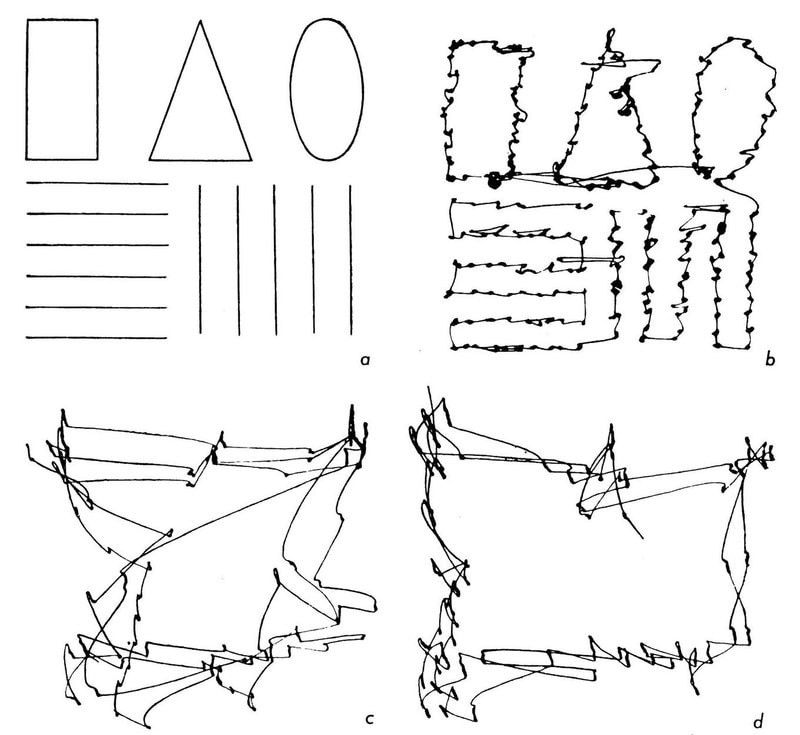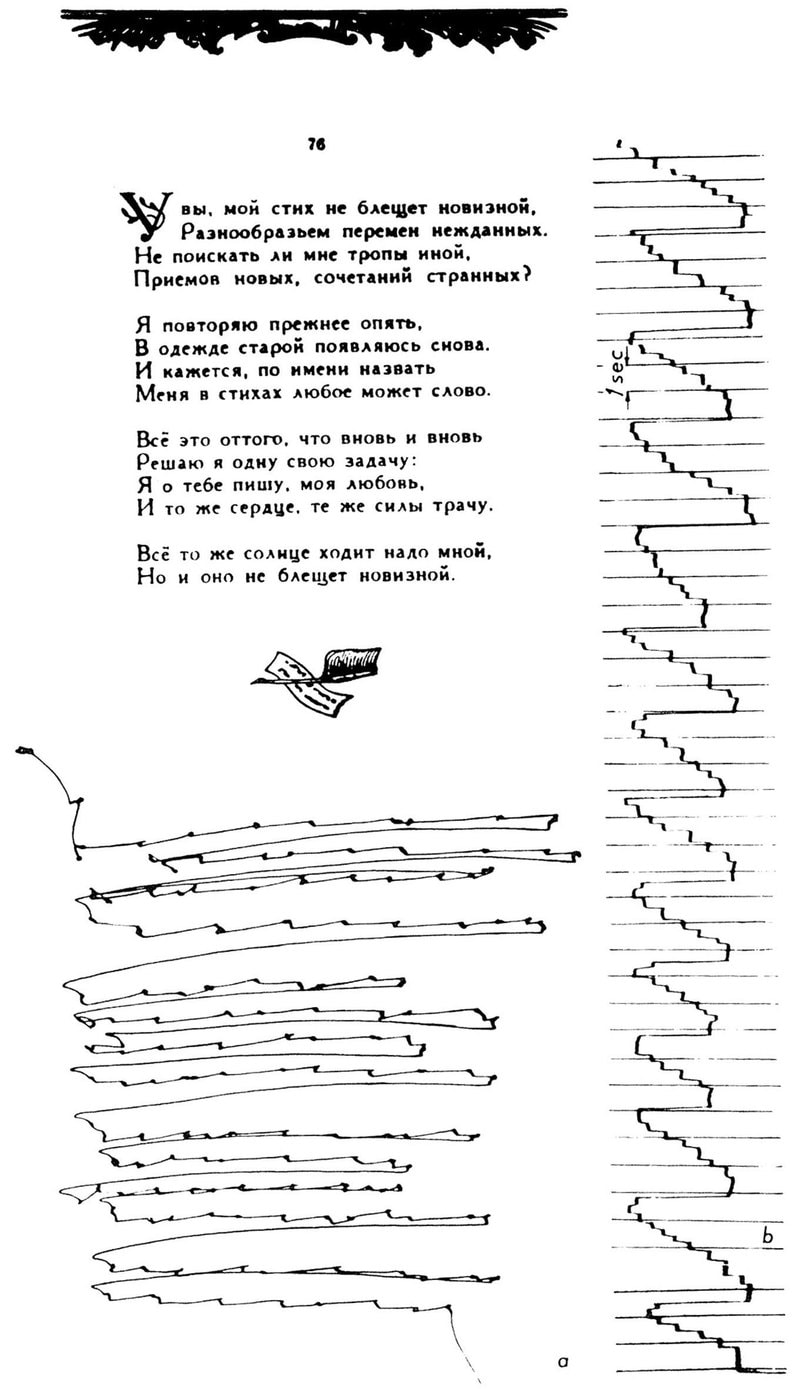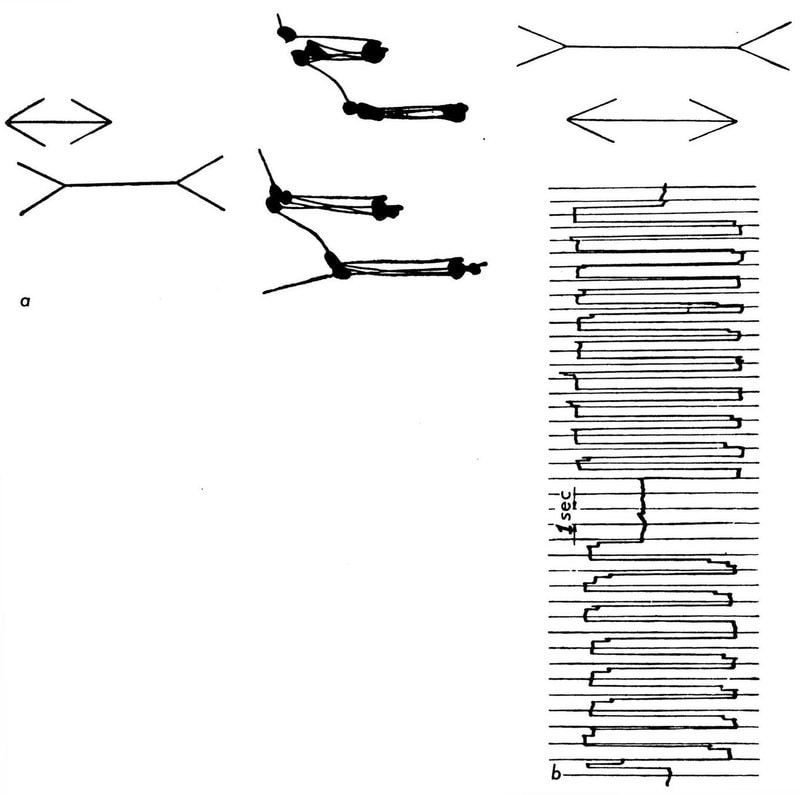The aspect of Yarbus’s book that has attracted contemporary researchers is the final chapter on the perception of complex objects. The effects of attention on eye movements have been addressed above and the three aspects that we will examine here are eye movements over patterns, reading and illusions. The general conclusion by Yarbus was: “All the records given in this chapter, as well as others not mentioned here, show conclusively that the character of the eye movements is either completely independent of or only very slightly dependent on the material of the picture and how it was made, provided that it is flat or nearly flat” (1967, p. 190). Eye movements over three classes of complex objects were examined: geometrical patterns, text (reading), and configurations that evoke illusions.
Yarbus examined simple shapes and reached the conclusion: “Some readers may think that during the perception of stationary objects the human eyes are able to perform smooth pursuing movements in addition to saccades. Where stationary objects are concerned, this view is incorrect. It is due to the fact that the small saccades of the eyes are performed involuntarily and we are not aware of them”. Yarbus’s records of eye movements over simple geometrical patterns are shown.

“Record of eye movements during examination of geometrical figures. a) Geometrical figures presented to the subject for examination; b) record of eye movements during which the subject tried to trace the lines of the figures with his eye smoothly and without saccades; c) record of eye movements during free (without instruction) examination of the figures for 20 sec: d) record of eye movements during examination of the figures for 20 sec after the instruction ‘look at the figures and count the number of straight lines’.” (Yarbus, 1967)
With regard to reading Yarbus wrote: “Since I have not personally made any detailed study of eye movements during reading, the data given in this section are mainly compiled from other sources”. Despite this statement, Yarbus did record eye movements during reading.

“Record of eye movements of a subject reading a Shakespeare sonnet. Record on stationary photosensitive paper (a) and on moving phototape of a photokymograph (b)” (Yarbus, 1967).
Yarbus examined ‘Optical illusions and eye movements’ as well as ‘Eye movements during perception of moving objects’ but, surprisingly, he did not investigate motion illusions. He was aware that “several authors have tried to explain the appearance of well- known optical illusions by movements of the eyes” but he did not say who the authors were. His first experiments involved presenting optically stabilised illusion figures (with the suction cap) and: “It was found that all the illusions persisted; consequently, they cannot be attributed to eye movements”. This was further supported by illuminating illusion figures with very brief flashes of light; not only were the illusions still present but they could still be seen in the afterimages from the bright light flashes. Nonetheless, he did record eye movements when observing the Müller-Lyer illusion.

“Optical illusion: both horizontal lines are of equal length. Records of eye movements accompanying comparison of length. a) On stationary photographic paper; b) made with photokymograph” (Yarbus, 1967).
Yarbus found that “Many experiments such as that illustrated … show that the subjects subjective evaluation may always be judged from the eye movements made during comparison of the distances”. Subsequent eye movement studies of the Müller-Lyer illusion have generally supported the results obtained by Yarbus, although Yarbus’s work is rarely cited. Because Yarbus showed that the illusions still occurred with stabilised images he concluded: “eye movement has no appreciable effect on the presence of many illusions. On the other hand, as the records show, the presence of illusions appreciably influences the amplitude of the saccades accompanying the evaluation of distances”. His final sober assessment of illusions applies as much today as it did when it was written: “The origin of many illusions is not yet known, however; the explanations advanced to date cannot be regarded as convincing. Different illusions influence eye movements to different degrees and in different ways. At the same time, some optical illusions have no influence whatever on eye movements”.
In the Conclusion to Eye movements and vision Yarbus states: “The human eyes voluntarily and involuntarily fixate on those elements of an object which carry or may carry essential and useful information. The more information is contained in an element, the longer the eyes stay on it. The distribution of points of fixation on the object changes depending on the purpose of the observer, i.e., depending on the information which he must obtain, for different information can usually be obtained from different parts of an object. The order and duration of the fixations on elements of an object are determined by the thought processes accompanying the analysis of the information obtained. Hence people who think differently also, to some extent, see differently.”